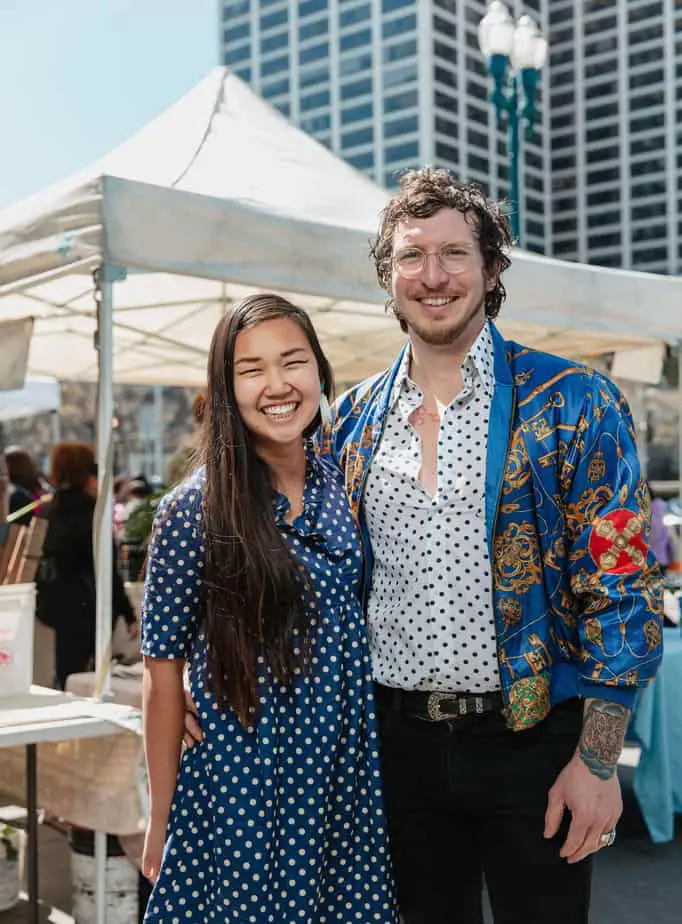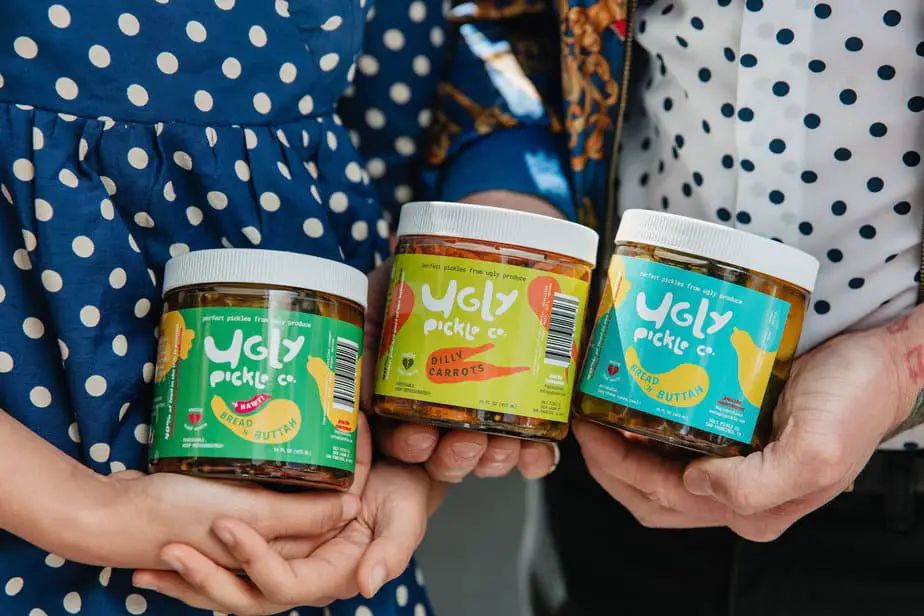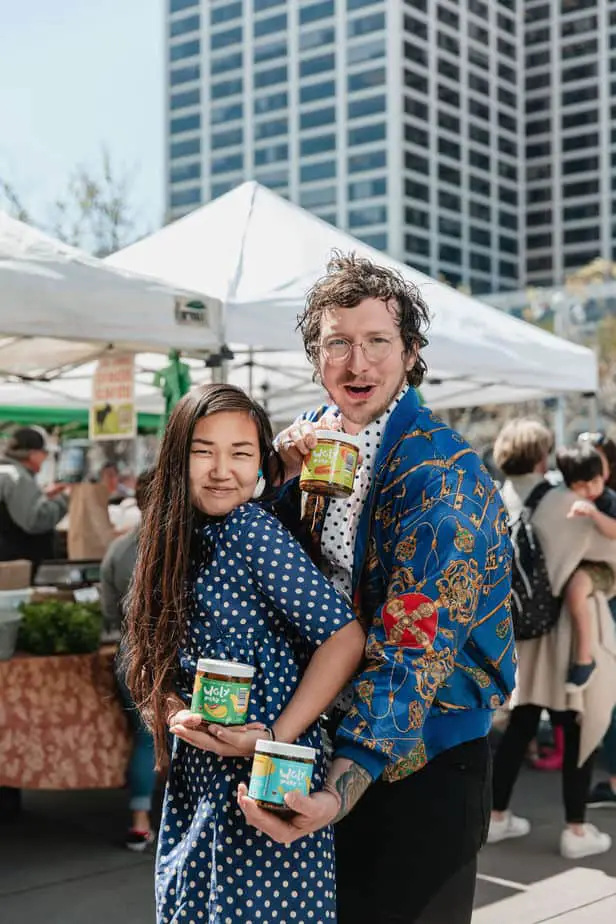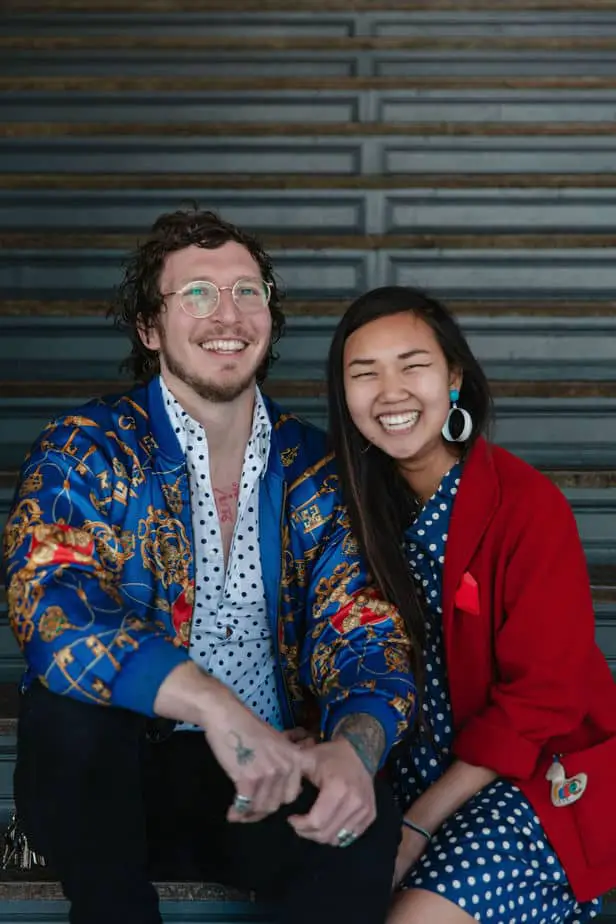As I get closer to the beautiful blue arches, both Abe and Murphy are standing poised in matching polka dot numbers which were “planned, but not really.” I’m welcomed by hugs as I greet them—the two have an energy that radiates utter good vibes. A warmth comes off when they smile in unison over funny puns and shared anecdotes of mutual friends. We make our way around the farmers market, the two showing me where they set up normally for a Saturday morning rush, the farmers they love and love working with; gleefully giving praise to the variety of produce farmers and their teams. The two are walking hand-in-hand in effortless unison, they seem to know each other very well. “David and I met funnily enough at the Ferry Building during one of CUESA’s events that we were both working,” Abe tells me as we make our way around the booths and people shopping for fresh produce, “It was a cocktail party and I was writing an article at that point looking for a chef’s perspective and he happened to be there. I wrote the article, he went and did his restaurant thing and probably three weeks after that, I was in his restaurant and he happened to remember me. I was like “Oh hey! Did you read the article?” and he said, “No! Did you try the dish that I recommended?” So he brought me out the dish and then asked me out [laughs].”
Seemed simple enough, but the path to starting a company about food waste on the other hand, was a bit more grueling a venture. For Abe and Murphy, however, it’s a mutual platform that took them off into the world of entrepreneurs. You may be asking, “food waste? How are we wasting food?” In fact, Americans waste an unfathomable amount of food. According to a Guardian report by Suzanne Goldenberg released in 2017, roughly 50 percent of all produce in the United States is thrown away—some 60 million tons (or $160 billion) worth of produce annually, an amount constituting “one third of all foodstuffs.” Thankfully, the numbers have changed significantly since then. Abe was shocked at how Americans treated food, “40% of the food in the U.S. is wasted, REALLY, actually trashed and at the same time, agriculture is the second contributor to climate change,” she tells us with a stiffness in her voice, “so we’re wasting precious resources like water, land use, energy to something that’s being thrown away and even at a micro-scale we saw it here at the San Francisco Farmers Market. This is where we met, and we would hear from different farmers that we knew or who we met that this was an issue.”
In 2016, the Atlantic reported that, “a major reason is that food is cheaper in the United States than nearly anywhere else in the world, aided (controversially) by subsidies to corn, wheat, milk, and soybeans. But the great American squandering of produce appears to be a cultural dynamic as well, enabled in large part by a national obsession with the aesthetic quality of food. Fruits and vegetables, in addition to generally being healthful, have a tendency to bruise, brown, wilt, oxidize, ding, or discolor and that is apparently something American shoppers will not abide.” The American standard of having perfect looking food has led to our belief that if food looks bad, it tastes bad. To Murphy, it shouldn’t have ever been the case, “At the time, I was the chef over at White Chapel and farmers would just give me boxes of not sellable produce by the cases, I would say “I don’t need this stuff,” and often they would respond “no, please take it for free, if you don’t it’s just going to be tilled back into the soil.”
Both Abe and Murphy have had their eyes on the food business for years—both respectfully working in a variety of non-profits, restaurants, major supply chains and the lot. Abe herself discovering family roots tied in agriculture, “I always felt really tied to sustainable agriculture, my background in working with nonprofits in sustainable AG [agriculture]. Plus learning that my entire families history has been tied to agriculture. My dad’s side were all farmers in the Salinas Valley and now I’m only realizing that this is coming so full circle. I guess I always knew that agriculture was tied to my family but it was never apart of my personal identity.”
For Murphy, being a chef and entrepreneur came naturally—a confidence that comes with years of learning experiences, “I’ve started a few kitchens at several different restaurants as an opening chef and I knew that I could take on a project like that but really, Kayla and her mom are two big inspirations for me.” Looking in Abe’s direction with a smile ear-to-ear. “They just get it, super aspirational and continue to push me for what I want.”
And the start of Ugly Pickle Co. started as chemically as their relationship—a concept the two have had on their minds since their personal experiences with food and waste. “At the time [while being a chef at White Chapel], I was making this at-home salsa and a couple people had asked me to bottle it and give it to them,” Murphy describes to me as they hand me their three popular Ugly Pickle Co. flavors to try at home, “so we were talking about that and I added that I wanted to use produce that didn’t make the cut to the farmers and Kayla responses with “I had this same idea six years ago, we should totally do this.” Abe adds on, “I was looking at my notes from four to five years ago and one note read, “start a food waste company.” It had been on my mind as well that this would be an impactful agriculture conversation and it just so happened that we are good partners.”
Off the races the two were with the creation of Ugly Pickle Co. but in my head, what did Ugly Pickle Co. even mean? Was it only pickles they were saving? Abe divulges, “Ugly was in relation to food waste, part of our mission is sequestering food waste things that would have been food waste, even though that’s one facet of what we do.” Murphy adding in, “we were also trying to get away from buzzwords like “Imperfect” to not associate ourselves with our brands.”
The two are on the cusp of a blooming industry forming what seems to be over night, companies such as Imperfect Produce, Hungry Harvest, 412 Food Rescue. Seeing opportunity in the market to dive into the soil head first garnered the attention of the produce industries not looking to make change or to help the current exoskeleton of food waste. Though not without criticism, capitalist America still reins supreme. Abe, however, isn’t shaken in her and Murphy’s quest to address food waste as a serious U.S. crisis. “Our food system is broken right now, we’re so disconnected right now from the people growing our food and even here at the Farmers Market there is this almost nostalgic sense of how we used to eat and how we connected with those who grow our food. I think that some people come here and almost feel like this is a novelty.”
Abe is confident in her conviction—she feels that all hands on deck further push the narrative of a sustainable food world. “Officially we’ve been on the market for three months, we’re babies,” she smiles as she proudly tells me, “of course, it’s been a work in progress, realistically it’s more than a year and a half. We knew we wanted to do something impactful with the environment and related to food.”
At this moment, Murphy has to split to another engagement—he wraps me in a full hug and thanks me for my time, he’s thrilled to see Ugly Pickle Co. article come to life. Abe and I walk him to his car where he’s conveniently parked in front of the Ferry Building. “You’re bold for parking here” I say looking at his vehicle. “I have a Farmers Market sticker, so we get the good parking [laughs]”—he kisses Abe and zooms away.
Abe and I take the conversation to the adjacent Blue Bottle where we got to the knitty-gritty of being a business duo. In 2018, nearly 238,566 businesses were accounted for in the city alone—how does a new company like Ugly Pickle Co. stand out from the masses? To Abe, it’s all about the conversation that UPC will have with people, “we’re trying to introduce that conversation to urban sprawl and city dwellers in an approachable way, like pickles are just fun, we eat them on everything—they’re a fun pop to any meal,” she says about brand. “And with the branding, we wanted to create that pop when you pick up the jar. Evoking fun and whimsy because at hand, it’s a serious topic and it’s a scary reality. Even the farmers we work with in the Capay Valley say that, “well, carrots are looking very slim because how muddy it is out there with all the rains that have been happening out there.” And it becomes a chain reaction.”
The conversation begins to really address the issues that climate change, resource waste, and human instinct play into the greater dialogue. “We understand there is a luxury now of going to the Farmers Market, most happen during a work day, but also it’s a time issue,” Abe explains to me with a sternness in her voice, “people expect food to be really cheap, they don’t understand the labor, time, and processes in creating a single tomato. And people want that at less than fifty cents. When you come to a Farmers Market and you have the opportunity to talk to a farmer who works closely on growing those tomatoes, you see how much care they put into their work. It’s astounding.”
But it hasn’t been all rainbows and fresh produce in starting this company, everything from FDA regulations, permits from the city, and even the initial reception of the public gave Abe and Murphy a run for their money—literally. “The consumer (in the SF Bay Area) is pretty well versed in the systemic issues surrounding food,” Abe assures me, “I do remember first iterations of our brand where we would put “FOOD WASTE” on the label and people freaking out when they saw that. They thought it was trash. They think ‘dumpster diving and freaky processes’ when they come to our booth. We’re still working on distilling our language because the topic is still overwhelming.” Education to Abe, however, is key in making sure customers are becoming aware of what’s going in their mouth.
“It’s a lot of one-on-one conversations with those who come to our booth,” Abe explains, “and this is a great place to start and it only takes five minutes to talk to those who want to learn more about our food system and what it means for the global food economy. I gave a seven year old girl a lesson the other day on food systems 101 and I showed her pictures of ugly produce that we upcycled into our product. She tried everything, we had a dialogue, and ultimately in time we will be on shelves so it will be different.”
Though, depending on how humans take the course, food waste could become a serious issue by 2050. According to the Future Agenda Organization, an organization that maps trajectory for world issues, estimates that “…the world will need 60 per cent more calories every day to feed 9 billion people.”
The study elaborates, “if we could reduce current food waste by just a quarter, that would be enough to feed all of the world’s hungry. If we can reduce it by half then we will free up enough to cope with an extra billion or so people on the planet. By 2050 the world will need 60 per cent more calories every day to feed 9 billion people. Cutting current food loss and waste levels in half will shrink the gap by 22 percent.” Abe attests to this, “Climate and food waste is one of the most pressing issues of our time and we have to work on solutions in the immediate future in order to stay on this planet. Nature will correct itself, it’s just a matter if humans want to stay on this planet. We don’t realize that…until we can’t get ahold of something or when it becomes an inconvenience to us. And we want to be that touch point before it becomes an inconvenience.”
But like a snake that eats its own head, we often don’t see how we are the cause of our own suffering . The study goes on to report that, “Today, across the world, we have no meaningful food waste data. If, as we move forward, robust and consistent data collection occurs and is used to both improve farmer education, highlight process efficiency opportunities and support clearer guidelines for consumers, then we should be able to make significant progress.”
And the part about farmer education ultimately comes at a time when the agriculture sectors of America are getting the short end of the stick.
“Most of our farmer connections are hold friends of ours that we’ve talked to about this problem previously,” Abe tells me as we near the end of our conversation, “we have heard of a lot of companies that do food upcycling (from farmers) that come up to them and demand their product for cheap because they know they’re going to get rid of it. At Ugly Pickle, we want our farmers to be well-compensated because they do the vast majority of the work here. We’re paying them fairly for their stuff that may have not made a lot of money on. We will have multiple conversations with them about what excess they are foreseeing, they often work from texting, FB messenger, they will message and say, ‘hey, we have 100 pounds of cucumbers that we need to move this week, do you want them?’”
Abe and Murphy are excited by the future possibilities, only have been on the market for three months officially, the two have their work respectively cut out for them. “Our hope now, after getting our sea legs at the Farmers Market, is moving into retail,” she says grinning ear to ear, “so primarily family-owned grocery stores, independents, ultimately we want to scale this and make this a scalable model where people can learn more about reversing climate change and supporting our farmers on a larger scale, recovering waste on the global waste.”
For the duo, every day is a new start and taking the appropriate steps in order to maintain the mission personally and professionally envelop the day-to-day, “for us, as humans existing on this planet, the biggest things we can do to reverse issues like climate change is all about changing our patterns in the ways that we consume ultimately,” Abe states.
We’ll cheers to that.
// Ugly Pickle Co. eatuglypickle.com, you can find the duo every Saturday morning at the Farmer’s Market at their UPC booth; photography by Maisie Leung at the Ferry Building.



